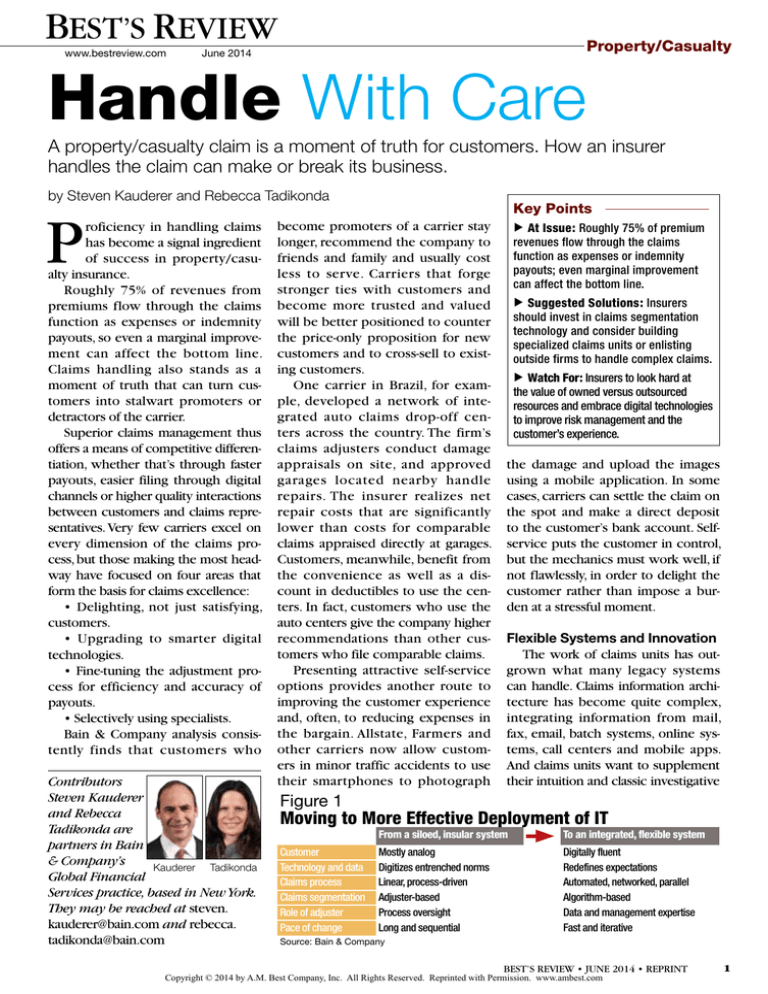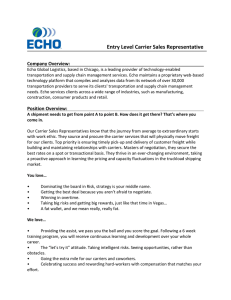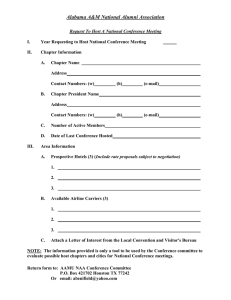
BEST’S REVIEW
www.bestreview.com
Property/Casualty
June 2014
Handle With Care
A property/casualty claim is a moment of truth for customers. How an insurer
handles the claim can make or break its business.
by Steven Kauderer and Rebecca Tadikonda
Contributors
Steven Kauderer
and Rebecca
Tadikonda are
partners in Bain
& Company’s
Kauderer Tadikonda
Global Financial
Services practice, based in New York.
They may be reached at steven.
kauderer@bain.com and rebecca.
tadikonda@bain.com
Key Points
▼
At Issue: Roughly 75% of premium
revenues flow through the claims
function as expenses or indemnity
payouts; even marginal improvement
can affect the bottom line.
Suggested Solutions: Insurers
should invest in claims segmentation
technology and consider building
specialized claims units or enlisting
outside firms to handle complex claims.
▼
become promoters of a carrier stay
longer, recommend the company to
friends and family and usually cost
less to serve. Carriers that forge
stronger ties with customers and
become more trusted and valued
will be better positioned to counter
the price-only proposition for new
customers and to cross-sell to existing customers.
One carrier in Brazil, for example, developed a network of integrated auto claims drop-off centers across the country. The firm’s
claims adjusters conduct damage
appraisals on site, and approved
garages located nearby handle
repairs. The insurer realizes net
repair costs that are significantly
lower than costs for comparable
claims appraised directly at garages.
Customers, meanwhile, benefit from
the convenience as well as a discount in deductibles to use the centers. In fact, customers who use the
auto centers give the company higher
recommendations than other customers who file comparable claims.
Presenting attractive self-service
options provides another route to
improving the customer experience
and, often, to reducing expenses in
the bargain. Allstate, Farmers and
other carriers now allow customers in minor traffic accidents to use
their smartphones to photograph
Watch For: Insurers to look hard at
the value of owned versus outsourced
resources and embrace digital technologies
to improve risk management and the
customer’s experience.
▼
P
roficiency in handling claims
has become a signal ingredient
of success in property/casualty insurance.
Roughly 75% of revenues from
premiums flow through the claims
function as expenses or indemnity
payouts, so even a marginal improvement can affect the bottom line.
Claims handling also stands as a
moment of truth that can turn customers into stalwart promoters or
detractors of the carrier.
Superior claims management thus
offers a means of competitive differentiation, whether that’s through faster
payouts, easier filing through digital
channels or higher quality interactions
between customers and claims representatives. Very few carriers excel on
every dimension of the claims process, but those making the most headway have focused on four areas that
form the basis for claims excellence:
• Delighting, not just satisfying,
customers.
• Upgrading to smarter digital
technologies.
• Fine-tuning the adjustment process for efficiency and accuracy of
payouts.
• Selectively using specialists.
Bain & Company analysis consistently finds that customers who
the damage and upload the images
using a mobile application. In some
cases, carriers can settle the claim on
the spot and make a direct deposit
to the customer’s bank account. Selfservice puts the customer in control,
but the mechanics must work well, if
not flawlessly, in order to delight the
customer rather than impose a burden at a stressful moment.
Flexible Systems and Innovation
The work of claims units has outgrown what many legacy systems
can handle. Claims information architecture has become quite complex,
integrating information from mail,
fax, email, batch systems, online systems, call centers and mobile apps.
And claims units want to supplement
their intuition and classic investigative
Figure 1
Moving to More Effective Deployment of IT
Customer
Technology and data
Claims process
Claims segmentation
Role of adjuster
Pace of change
From a siloed, insular system
To an integrated, flexible system
Mostly analog
Digitizes entrenched norms
Linear, process-driven
Adjuster-based
Process oversight
Long and sequential
Digitally fluent
Redefines expectations
Automated, networked, parallel
Algorithm-based
Data and management expertise
Fast and iterative
Source: Bain & Company
Best’s Review • June 2014 • REPRINT
Copyright © 2014 by A.M. Best Company, Inc. All Rights Reserved. Reprinted with Permission. www.ambest.com
1
Property/Casualty
methods with data analytics, in order
to make better decisions.
Carriers thus have been investing in new information technology,
including a shift to external modular solutions provided by Guidewire
and other firms (see Figure 1). The
challenge will be to reap value from
these investments, by moving beyond
process efficiency to using IT in ways
that reinforce close connections with
customers and inform better decision-making. Here’s a taste of the digital innovations now available:
• Mattersight software listens to
claims interviews for various carriers in order to discern whether the
claimant is being truthful.
• EagleView relies on satellite imaging to identify pre-existing conditions
and estimate storm damage to roofs,
eliminating the need in most cases for
an adjuster to visit the property.
• Enservio software estimates the
value of contents in a home based
on demographic and other information. If a house is destroyed, the carrier can make a payout three times
faster than processing a traditional
bank check, and sharply reduce timeconsuming negotiations.
These and other innovations give
adjusters new tools to determine payouts. But it’s also essential that carriers
adapt their processes so adjusters can
use the data to make better decisions.
Aligning Everyone’s Incentives
With so much value at stake in the
claims process, it’s worth a renewed
push to ensure that carriers make the
right payout through a more efficient
process, in ways consistent with a
positive customer experience.
Some carriers overpay, on average,
by 10% to 12%, in large part because
they skimp on adjustment resources
or rely too heavily on independent
adjusters. To improve the process,
therefore, leading carriers are investing in capabilities for smarter claims
segmentation up-front (see Figure 2.)
Their most experienced adjusters handle the most complex and large-loss
claims, with some of these adjusters
2
Best’s Review • June 2014 • REPRINT
specializing in certain types of claims.
The simpler claims can be handled by
less-experienced, lower-cost staff and
auto-adjudication software.
Leading companies such as
Chubb go a step further, deploying
sophisticated models for faster, more
accurate triaging and routing of
claims. This allows Chubb to deliver
exceptional claims service and payout at the appropriate amount, not
a penny more or less. As a result, for
both personal and commercial lines,
Chubb has the lowest loss ratio of
the largest carriers, relatively high
customer loyalty scores in its markets and stable premiums in a turbulent environment.
With smarter segmentation in
mind, some carriers find it increasingly attractive to outsource the
straightforward majority of claims,
while keeping more complex and
high-value claims in-house. XL, for
instance, uses a network of several providers and just a handful of
employees to oversee its claims. As
an alternative, a number of carriers
have opened their own offshore facilities in low-cost locations.
Regardless of who handles the
claim, carriers need to choose and
manage vendors and service providers, such as car repair shops and
medical doctors, with greater care.
It’s critical to develop a trusted panel
of preferred providers that adhere
to contracts based on performance,
with distinct service levels and fee
arrangements to ensure consistent,
high-caliber service on behalf of carriers and customers.
Knotty Claims Untangled
For a typical large carrier, complex
claims represent only 5% of cases but
70% of payouts. In response, more
carriers have been using expert specialists, either by building specialized
claims units or enlisting outside firms.
Santam, a South African multiline
insurer, captures key risk indicators
when claims are made and triages
them into five categories. It settles
immediate claims with no further
assessment. Merit claims with a high
fraud risk are handed to specialists.
Other categories may require a visit
by a Santam operative. Through triage and greater reliance on specialists, Santam has speeded up its claims
processing by 90% for low-risk claims,
reduced fraud with its attendant costs
and further cut costs through a faster
process and fewer visits.
Specialist expertise is proving
particularly valuable in three areas:
Litigation management. Forward-thinking carriers have been
working to actively prevent litigation. They’ve also upgraded their inhouse counsel and winnowed their
external panel to a smaller number
of law firms, with greater attention to
aligning incentives and focusing on
outcomes rather than billable hours.
Figure 2
Thoughtful Segmentation Upfront
Can Reduce Total Claims Costs
Type of specialization
Highly
centralized
Express claims
Large-loss claims
Level of
centralization
Complex claims
Decentralized
Automation
Source: Bain & Company
Network (assistance, relationship, negotiation)
Customization
Fraud detection. Among the
people disposed to committing
fraud, there is perfect information
on the street—they know the vigilant and complacent carriers, and
tend to target the latter. So it’s
important for carriers to aggressively
pursue the bad guys through tactics including innovative use of data
sources and software that recognizes
patterns of suspicious behavior.
CNA, a U.S. commercial lines
carrier, has tackled the problem
through a special fraud unit comprised of two dozen employees
with military and law enforcement
backgrounds. The company worked
with SAS to build a predictive model
that identifies connections among
multiple claims, such as doctors
consistently charging the maximum billable hours. Within a year of
implementing the model, CNA had
recovered or prevented fraudulent
claims totaling more than $2 million.
Medical management. Carriers have found value in developing a
strong network of health care providers that will ensure the right treatment, through outcome-based reimbursement, at reasonable rates. Their
double-check of medical necessity
can substantially lower costs.
Effective networks emphasize
accurate procedure coding and associated bill review. They use nurses
and telephone interactions whenever appropriate to manage cases.
And for workers’ compensation, it’s
critical to steer policyholders to providers that not only ensure the right
medical treatment but also expedite return to any form of light-duty
work, which limits indemnity.
Lower-level adjusters will handle
most claims, and for this group, carriers will emphasize throughput
and efficiency, as directed by experienced supervisors. Some of those
adjusters, along with outside hires,
will then be trained and developed
to take on more complex or largeloss claims, and perhaps move into
specialty lines.
Carriers that aim to fuel long-term
growth, regardless of their strategy
or target segments, will take a more
systematic and customer-centered
approach to claims management.
They will look hard at the value of
owned versus outsourced resources.
And they will embrace digital technologies to improve risk management and the customer’s experience—and ultimately, to enhance
BR
their economics.
Fuel for Future Growth
Many of the recent shifts in claims
management have major implications for carriers’ organizations. For
example, carriers that pursue outsourcing aggressively will need fewer
adjusters. For those adjusters who do
remain in-house, we expect a dualpath model to become the most sustainable path.
Best’s Review • June 2014 • REPRINT
3








